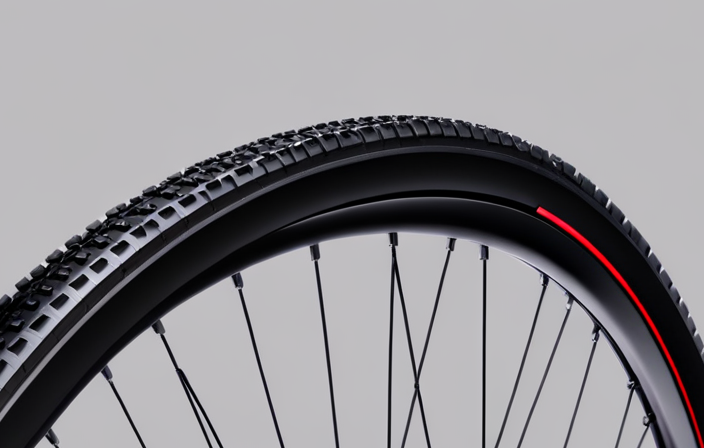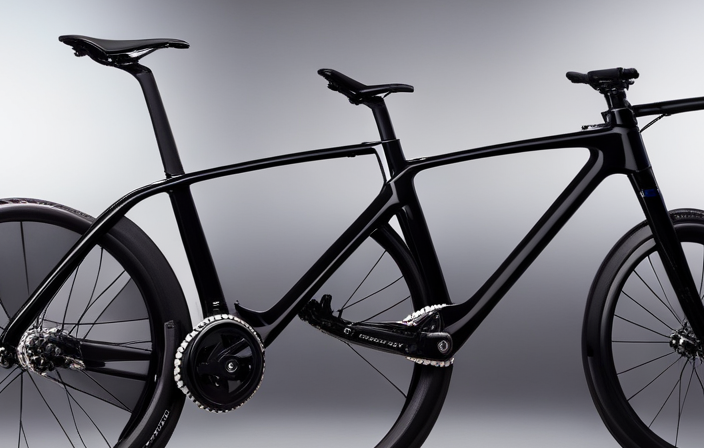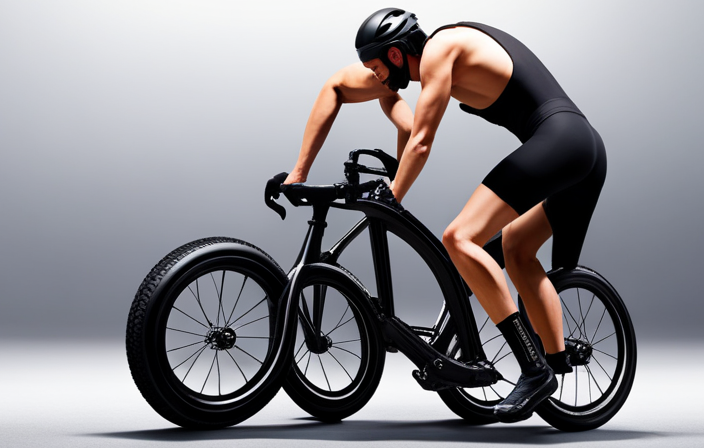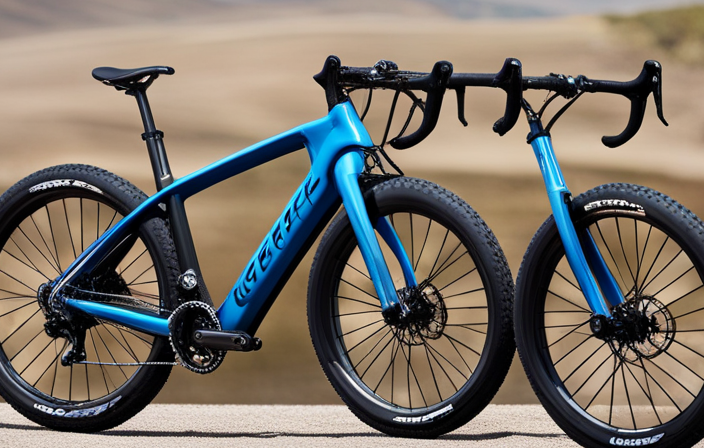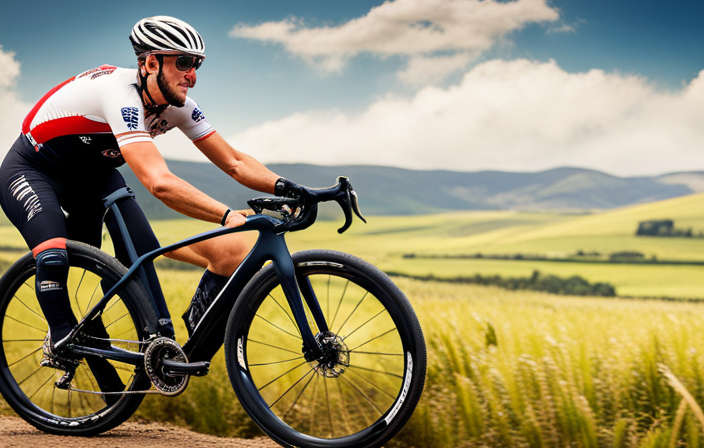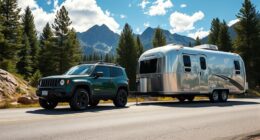Are you fed up with the constant challenge of finding the right tire pressure for your gravel bike races? Look no more!
In this article, I will reveal the secrets behind determining the perfect tire pressure for maximum performance and grip on varied terrains. We’ll delve into factors such as tire width, tread pattern, and race conditions to help you unlock the ultimate potential of your bike.
Get ready to leave your competitors in the dust as we explore the world of gravel bike racing and discover the ideal tire pressure for victory.
Key Takeaways
- Tire pressure impacts performance and speed on rough terrain.
- Finding the right balance of tire pressure is crucial for traction and control.
- Factors such as rider weight, surface conditions, and personal preference should be considered when determining tire pressure.
- Regularly evaluate and fine-tune tire pressure for optimal performance.
Importance of Tire Pressure in Gravel Bike Racing
You need to understand the importance of tire pressure in gravel bike racing. Tire pressure has a significant impact on performance, and finding the optimal tire pressure range is crucial for achieving maximum speed and efficiency on rough terrain.
When it comes to gravel bike races, where traction and control are essential, tire pressure plays a vital role.
The right tire pressure can provide better grip on loose surfaces, allowing you to maintain stability while maneuvering through corners or tackling technical sections. It also helps absorb vibrations and impacts from uneven terrain, providing a more comfortable ride and reducing fatigue.
On the other hand, if your tires are overinflated, you risk losing traction and experiencing a harsher ride; while underinflated tires may cause excessive rolling resistance and increased chances of pinch flats.
To find the optimal tire pressure range for your gravel bike races, consider factors such as rider weight, surface conditions, weather conditions, and personal preference. Experiment with different pressures during training rides to determine what works best for you.
Remember that higher pressures typically offer lower rolling resistance but sacrifice some comfort and traction. Conversely, lower pressures offer improved traction but may increase rolling resistance.
Understanding these factors will help you make informed decisions when determining your tire pressure for gravel bike races without compromising performance or safety.
Factors to Consider When Determining Tire Pressure
When determining the optimal tire pressure for gravel bike races, there are three key factors that need to be taken into consideration.
Firstly, rider weight and bike load play a crucial role in determining the right tire pressure. The heavier the rider or the more gear they are carrying, the higher the tire pressure should be to avoid pinch flats.
Secondly, terrain and surface conditions must be considered as they affect how much traction is needed and how well the tires can grip the surface.
Lastly, weather and temperature also have an impact on tire pressure, as hotter temperatures may cause tires to expand and require slightly lower pressures for better performance.
Rider Weight and Bike Load
Rider weight and bike load have an impact on the recommended tire pressure for gravel bike races. When determining the optimal tire pressure, it is crucial to consider these factors as they directly affect performance and safety. Here are four key considerations:
-
Rider weight adjustment: Heavier riders should increase tire pressure to maintain proper support and prevent pinch flats.
-
Optimal load distribution: Properly distributing the weight of bike accessories, gear, and water bottles ensures better stability and handling.
-
Tire sidewall strength: Higher pressures may be required for riders with heavier loads or aggressive riding styles to avoid sidewall damage.
-
Rim width compatibility: Wider rims allow for lower tire pressures without sacrificing stability.
Considering these factors allows riders to fine-tune their tire pressure based on individual circumstances.
Transitioning into the next section about terrain and surface conditions, it is essential to adjust tire pressure accordingly to optimize grip and control while navigating different types of gravel surfaces.
Terrain and Surface Conditions
To optimize your grip and control on various types of terrain and surface conditions, it’s important to consider the specific characteristics of each.
Surface condition analysis is crucial in determining the optimal tire pressure for gravel bike races. Different surfaces, such as loose gravel, hard-packed dirt, or muddy trails, require different levels of tire pressure to maximize performance.
For example, on loose gravel surfaces, lower tire pressures can provide better traction by allowing the tires to conform to the uneven terrain. On the other hand, higher tire pressures are more suitable for hard-packed dirt surfaces as they reduce rolling resistance and improve efficiency.
By conducting a thorough surface condition analysis and adjusting tire pressures accordingly, riders can ensure that their bikes are equipped with the ideal grip and control for any given race course.
Transitioning into the subsequent section about weather and temperature, it’s also important to consider how these factors impact tire performance.
Weather and Temperature
Considering the weather and temperature is essential for optimizing your grip and control on different types of surfaces. Weather forecasting plays a crucial role in determining the appropriate tire pressure for gravel bike races. Here are four key factors to consider:
- Rainfall: Wet conditions require lower tire pressures to increase traction and prevent skidding.
- Temperature variations: Cold temperatures cause tire pressure to decrease, so it’s important to adjust accordingly.
- Wind speed: Strong winds can affect bike stability, so adjusting tire pressure can help improve control.
- Humidity levels: High humidity can make surfaces slippery, so higher pressures may be necessary for better grip.
By taking these factors into account, you can fine-tune your tire pressure to maximize performance based on the current weather conditions.
Transitioning into the subsequent section about the role of tire width and tread pattern, it is also important to consider how these elements interact with weather variables to optimize your ride.
The Role of Tire Width and Tread Pattern
The role of tire width and tread pattern is crucial in determining the performance of a gravel bike during races. When it comes to tire pressure, finding the right balance is key. Adjusting tire pressure can affect both power transfer and tire longevity.
If the tire pressure is too low, power transfer will be compromised as more energy is absorbed by the tires instead of propelling you forward. On the other hand, if the tire pressure is too high, it can lead to a harsher ride and increased risk of flats.
Tire width also plays a significant role in performance. Wider tires offer greater traction and stability on loose gravel surfaces, allowing for better control when cornering or descending at high speeds. Additionally, wider tires provide more cushioning and absorb impact from rough terrain, resulting in a smoother ride.
In terms of tread pattern, there are various options available depending on the race conditions. Aggressive tread patterns with larger knobs are ideal for muddy or wet terrains as they provide excellent grip. Conversely, smoother tread patterns with smaller knobs are better suited for dry or hard-packed surfaces where lower rolling resistance is desired.
Understanding the relationship between tire pressure and grip is essential for optimizing performance during gravel bike races. By finding the right combination of tire width and tread pattern, you can enhance your bike’s handling capabilities while maintaining optimal power transfer on any given course.
Understanding the Relationship Between Tire Pressure and Grip
You can optimize your grip on different terrains by understanding the relationship between tire pressure and traction. The tire pressure you choose for your gravel bike races not only affects your grip, but also impacts tire wear and braking performance.
Tire pressure plays a crucial role in maintaining an adequate amount of contact between the tire and the ground, which directly affects how much traction you have.
When it comes to tire wear, running lower pressures can increase the likelihood of sidewall cuts or punctures. This is because lower pressures allow the tire to deform more easily, increasing its vulnerability to sharp objects on the trail. On the other hand, higher pressures may lead to excessive wear in the center of the tread due to reduced contact patch size.
In terms of braking performance, tire pressure also plays a significant role. Higher pressures generally result in shorter stopping distances as they provide a more stable base for braking forces to act upon. However, excessively high pressures can cause tires to skid or lose grip during hard braking maneuvers.
Understanding this relationship between tire pressure and both tire wear and braking performance is essential for finding the sweet spot that optimizes both grip and durability. By experimenting with different pressures based on terrain conditions and personal preferences, you can find the ideal balance that maximizes your performance without sacrificing safety or comfort.
Finding the Sweet Spot: Experimenting with Tire Pressure
When it comes to finding the sweet spot for tire pressure, I always start with the recommended pressure range provided by the tire manufacturer.
From there, I make incremental adjustments to fine-tune the pressure based on my personal preferences and riding style.
It’s important to experiment with different pressures on various terrains to determine what works best for optimal grip and performance.
By taking these steps, I can ensure that my tires are dialed in for gravel bike races and have a competitive edge on any surface.
Starting with Recommended Pressure Range
To determine the ideal tire pressure for gravel bike races, start by checking the recommended pressure range. This is crucial because tire pressure plays a significant role in ensuring safety on rough terrains. Riding with too low or too high tire pressure can increase the risk of flats, loss of control, and decreased traction.
The recommended pressure range typically takes into account factors such as rider weight, tire width, and riding conditions. While higher pressures may provide faster rolling speeds, lower tire pressures offer several benefits for comfort during long rides on uneven surfaces. Lower pressures allow tires to conform better to the terrain, providing improved grip and reducing vibrations that can cause fatigue.
Making incremental adjustments beyond the recommended range will be discussed in the subsequent section about finding the sweet spot for optimal performance.
Making Incremental Adjustments
After starting with the recommended pressure range for my gravel bike tires, I quickly realized that making incremental adjustments was necessary to fine tune the tire pressure. This process allowed me to optimize performance and find the perfect balance between traction and rolling resistance.
By slightly increasing or decreasing the pressure, I was able to feel subtle changes in handling and grip on different surfaces. It’s important to note that these adjustments should be made in small increments, as even a few PSI can have a noticeable impact on ride quality.
Taking the time to experiment and find the ideal tire pressure for specific race conditions is crucial for achieving peak performance. With this knowledge in mind, let’s move on to testing different pressures on various terrains to further optimize our gravel bike setup.
Testing Different Pressures on Various Terrains
For optimal performance, you should experiment with different tire pressures on a variety of terrains. Testing methods are crucial in determining the ideal pressure for your gravel bike races. By adjusting the tire pressure, you can fine-tune your bike’s performance to suit different surfaces and conditions.
To help you understand how different pressures impact bike performance, consider the following table:
| Terrain Type | Low Pressure (psi) | High Pressure (psi) |
|---|---|---|
| Loose Gravel | 30 | 40 |
| Hardpack | 40 | 50 |
| Wet Conditions | 35 | 45 |
Testing these pressures on various terrains will provide valuable insights into how they affect traction, rolling resistance, and overall handling. It is important to note that these values are just starting points, and further adjustments may be necessary based on personal preference and riding style.
Understanding the impact of tire pressure on comfort and efficiency will be discussed in the subsequent section.
The Impact of Tire Pressure on Comfort and Efficiency
When it comes to gravel bike races, the impact of tire pressure on comfort and efficiency cannot be underestimated. As a seasoned rider, I have spent countless hours experimenting with pressure to find the perfect balance between performance and ride quality.
Maintaining optimal tire pressure is crucial for maximizing both comfort and efficiency on various terrains.
Through my trials, I have discovered that lower tire pressures provide enhanced comfort by absorbing more of the vibrations and bumps encountered during rides. This reduces fatigue and allows for a smoother overall experience. However, excessively low pressures can result in higher rolling resistance, causing me to exert more effort to maintain speed.
Conversely, higher tire pressures improve efficiency by reducing rolling resistance and increasing speed. With less surface area in contact with the ground, less energy is wasted through friction. However, this also means sacrificing some of the cushioning effect provided by lower pressures.
Finding the right balance between speed and puncture resistance is essential in gravel bike races. It requires careful consideration of terrain conditions, rider weight, and personal preferences. By striking this delicate balance, riders can achieve optimal performance while minimizing the risk of flats.
Transitioning into the subsequent section about ‘balancing speed and puncture resistance,’ it is crucial to understand how tire selection plays a vital role in achieving these goals without compromising safety or performance.
Balancing Speed and Puncture Resistance
To achieve the right balance between speed and puncture resistance in your gravel bike races, it’s important to consider tire selection as a critical factor. Balancing speed and tire durability is key when it comes to optimizing performance on different race distances. One way to achieve this balance is by adjusting tire pressure.
Finding the optimal tire pressure for gravel bike races can be a bit of trial and error, but it’s worth the effort. Higher pressures generally provide lower rolling resistance and faster speeds on smoother surfaces, while lower pressures offer better traction and more comfort on rough terrain.
To help you visualize the impact of tire pressure on performance, consider the following table:
| Tire Pressure (psi) | Speed (mph) | Puncture Resistance |
|---|---|---|
| 40 | 16 | High |
| 30 | 15 | Medium |
| 20 | 14 | Low |
As you can see, higher pressures result in greater speed but sacrifice puncture resistance. Lower pressures may provide better puncture resistance but can slow you down.
In the next section, we will discuss tips for maintaining optimal tire pressure throughout your races without compromising performance.
Transitioning into the subsequent section about ‘tips for maintaining optimal tire pressure,’ it’s crucial to understand how proper maintenance can ensure consistent performance on various terrains.
Tips for Maintaining Optimal Tire Pressure
When it comes to maintaining optimal tire pressure, there are several key points to keep in mind.
First and foremost, regular pressure checks and adjustments are crucial to ensure peak performance and safety on the bike.
Additionally, knowing and utilizing proper tire inflation techniques is essential for achieving the desired pressure levels.
Lastly, always carry a portable pump or CO2 inflator with you during rides to quickly address any unexpected changes in tire pressure.
By following these tips, you can be confident that your tires are always at their best for every ride.
Regular Pressure Checks and Adjustments
Regular pressure checks and adjustments are necessary to ensure optimal performance for gravel bike races. As part of regular maintenance, monitoring tire pressure is crucial for both safety and efficiency. By maintaining the proper tire pressure, you can enhance traction, control, and overall ride quality on various terrains.
To help you understand the importance of regular pressure checks, here’s a table that illustrates the recommended tire pressures based on different factors:
| Terrain | Tire Width | Rider Weight |
|---|---|---|
| Gravel | 35mm | <150 lbs |
| >150 lbs | ||
| Pavement | 28mm | <150 lbs |
These guidelines serve as a starting point, but it’s essential to fine-tune your tire pressure through trial and error. Remember, proper tire inflation techniques play a significant role in maximizing your bike’s performance while ensuring a smooth and enjoyable ride.
Proper Tire Inflation Techniques
Ensure you use the correct inflation techniques to maximize your tire performance and enhance your overall riding experience. When it comes to proper tire inflation, using a reliable tire pressure gauge is crucial. This tool allows you to accurately measure the pressure within your tires and ensure they are inflated within the recommended tire pressure range. Maintaining the right tire pressure not only improves traction and stability on gravel surfaces but also reduces the risk of flats or pinch punctures.
To properly inflate your tires, start by removing the valve cap and attaching the gauge firmly onto the valve stem. Press down until you get a reading on the gauge display, which should ideally fall within the recommended range specified by your tire manufacturer. If needed, add or release air accordingly using a pump or an inflator until you reach the desired pressure.
Carrying a portable pump or CO2 inflator is essential for making quick adjustments on-the-go without interrupting your ride. These tools allow you to top up air pressure whenever necessary, ensuring optimal performance throughout your gravel bike races.
Carrying a Portable Pump or CO2 Inflator
Having a portable pump or CO2 inflator is crucial for making quick adjustments on-the-go during your rides. When it comes to choosing between a portable pump and a CO2 inflator, there are a few factors to consider.
First, a portable pump is more reliable as it doesn’t rely on cartridges that can run out.
Second, a pump allows you to fine-tune your tire pressure more precisely compared to the fixed amount of air provided by a CO2 cartridge.
Third, using a pump helps conserve resources as you can inflate your tires multiple times without having to purchase new cartridges.
Fourth, some pumps come with an integrated pressure gauge, allowing you to accurately measure and maintain the desired tire pressure.
Finally, pumps are compatible with both Presta and Schrader valves, while CO2 inflators may require adapters for certain valve types.
Now that we understand the importance of tire pressure and how to adjust it on-the-go using a portable pump or CO2 inflator, let’s explore the role of tubeless tires in gravel bike racing.
The Role of Tubeless Tires in Gravel Bike Racing
Tubeless tires play a crucial role in gravel bike racing. They offer several benefits that can significantly enhance performance on rough and unpredictable terrains. One of the main advantages is the ability to run lower tire pressures without the risk of pinch flats. This allows riders to have better traction and control, especially when navigating through loose gravel or bumpy surfaces. Additionally, tubeless tire technology advancements have made them more reliable and resistant to punctures, reducing the chances of unexpected flats during races.
The key to maximizing the benefits of tubeless tires lies in finding the optimal tire pressure for each race situation. It’s a delicate balance between running low enough pressure for improved grip and cushioning while avoiding excessive rolling resistance or bottoming out on sharp impacts. Factors such as rider weight, terrain conditions, and personal preference all come into play when determining the ideal tire pressure.
Transitioning into strategies for tire pressure management during races, it is essential to consider various factors before settling on a specific pressure range. By understanding how different pressures affect grip, comfort, and efficiency, riders can make informed decisions to optimize their performance throughout the race.
Strategies for Tire Pressure Management During Races
To optimize your performance during races, it’s important to consider various strategies for managing tire pressure. The right tire pressure can greatly impact your speed, control, and overall comfort on the gravel terrain. Here are some strategies for tire pressure management that you can experiment with:
-
Start with a baseline pressure: Begin by setting your tires at a moderate pressure that provides a good balance between grip and rolling resistance. This will depend on factors such as rider weight, tire width, and course conditions.
-
Adjust based on terrain: As you encounter different types of gravel surfaces during the race, be prepared to make adjustments to your tire pressure. Lowering the pressure slightly can improve traction on loose or rough sections, while increasing it can enhance efficiency on smoother sections.
-
Consider weather conditions: Wet or muddy conditions may require lower tire pressures to increase grip and prevent slippage. Conversely, dry conditions may benefit from slightly higher pressures for improved rolling resistance.
-
Listen to your bike: Pay attention to how your bike feels and sounds while riding. If you notice excessive bouncing or bottoming out over bumps, consider lowering the pressure. Conversely, if you feel sluggish or notice excessive sidewall flexing during hard cornering, try increasing the pressure.
-
Keep experimenting: Every rider has different preferences and riding styles. Don’t be afraid to experiment with different pressures in training rides before settling on what works best for you.
Understanding the effects of tire pressure on handling and cornering is crucial for optimal performance in gravel bike races. By finding the right balance between grip and rolling resistance through efficient tire pressure management techniques, you’ll be better equipped to tackle corners with confidence.
Understanding the Effects of Tire Pressure on Handling and Cornering
When it comes to understanding the effects of tire pressure on handling and cornering, you need to pay attention to how your bike responds in different situations. Tire pressure plays a crucial role in determining how your bike performs on gravel surfaces.
Lower tire pressure can provide better traction and increase stability by allowing the tires to conform to the irregularities of the terrain. However, it also increases rolling resistance and makes pedaling more difficult.
On the other hand, higher tire pressure reduces rolling resistance and improves efficiency, making it easier to maintain speed on smoother sections of the course. However, high tire pressure can result in reduced traction and a harsher ride when encountering rough patches or loose gravel.
Finding the right balance is key – too low or too high of a tire pressure can negatively impact your performance during a race. Experimentation is necessary to determine what works best for you based on factors such as rider weight, course conditions, and personal preference.
Overcoming common tire pressure challenges requires finding that sweet spot between low and high pressures that optimizes both grip and efficiency without compromising control.
Next, let’s explore some strategies for overcoming common tire pressure challenges during gravel bike races…
Overcoming Common Tire Pressure Challenges
As we dive deeper into the topic of tire pressure for gravel bike races, it is crucial to address the challenges riders commonly face when trying to find the optimal pressure. The right tire pressure can greatly impact your performance on various terrains, but it can be a tricky balancing act.
One common mistake riders make is running their tires too low or too high. Both extremes have their drawbacks. Running tires at a lower pressure can provide better traction and comfort, but it increases the risk of pinch flats and sidewall damage. On the other hand, higher pressures may offer faster rolling speeds, but they sacrifice grip and control.
To help you navigate these challenges, I have prepared a table that outlines some key factors to consider when finding the optimal tire pressure:
| Factor | Low Pressure | High Pressure |
|---|---|---|
| Traction | Excellent | Reduced |
| Rolling Speed | Slower | Faster |
| Control | Increased | Decreased |
| Risk of Damage | Higher | Lower |
By understanding these factors and considering your own riding style and preferences, you can find the ideal tire pressure for your gravel bike races. However, there is another important aspect of tire pressure that cannot be overlooked: preventing flats.
The Importance of Tire Pressure in Preventing Flats
Finding the optimal tire pressure is essential for preventing flats and maintaining a smooth ride on various terrains. When it comes to gravel bike races, choosing the right tire pressure becomes even more crucial.
Different bike types have different requirements for tire pressure. For instance, a cyclocross bike typically requires higher pressures than a mountain bike due to its narrower tires and smoother tread pattern. The benefits of using tubeless tires should also be considered. Tubeless tires allow for lower pressures without sacrificing performance, as they eliminate the risk of pinch flats caused by tubes. This means you can run lower pressures to improve traction on loose surfaces without worrying about punctures.
By understanding the relationship between tire pressure and flat prevention, you can make informed choices based on specific race conditions. In the next section, we will explore tips for choosing the right tire pressure for specific race conditions without compromising speed or stability on different terrains.
Transitioning into these tips from discussing the importance of tire pressure in preventing flats sets the stage for further exploration into this topic.
Tips for Choosing the Right Tire Pressure for Specific Race Conditions
To ensure optimal performance and stability on various terrains, consider these tips for selecting the appropriate tire pressure:
- Making pressure adjustments is crucial in optimizing tire performance and achieving the best results.
- When racing on gravel, find a balance between grip and rolling resistance.
- Lowering tire pressure can increase traction and provide better control on loose surfaces.
- However, excessively low pressures can lead to pinch flats or rim damage.
For dry and hard-packed gravel races:
- Slightly higher tire pressure is recommended.
- This helps reduce rolling resistance and allows for faster speeds.
- Aim for a pressure range between 40-50 psi to maintain stability without sacrificing too much comfort.
In wet or muddy conditions:
- Lower tire pressures are beneficial.
- They help the tires conform to uneven surfaces and improve traction.
- Start with around 30-40 psi but be prepared to adjust accordingly based on the specific conditions of the racecourse.
Remember, finding the right tire pressure involves some trial and error. Experiment with different pressures during training rides to determine what works best for you. Ultimately, it’s important to strike a balance that maximizes both speed and control while minimizing the risk of flats or other technical issues.
In conclusion, by understanding how tire pressure affects performance on different terrains, you can make informed decisions when preparing for gravel bike races.
Final Thoughts and Key Takeaways
In conclusion, it is crucial to experiment with different tire pressures in order to find the optimal balance between speed and control while racing on varied terrains.
Balancing performance and comfort is essential for gravel bike races, where the conditions can change drastically from smooth dirt roads to rocky trails. Adjusting tire pressure for different race distances is also important, as longer races may require more grip and stability.
To achieve the ideal tire pressure, consider these key points:
- Start by testing a higher pressure for faster rolling on smoother sections of the course.
- Decrease the tire pressure slightly to improve traction and control on rougher terrain.
- Find a sweet spot where you feel confident in your handling skills without sacrificing too much speed.
Remember that tire pressure is subjective and can vary depending on personal preference and riding style. It’s crucial to test different pressures during training rides or practice sessions before race day.
By fine-tuning your tire pressure based on the specific race conditions, you’ll have a better chance of performing at your best.
So, don’t be afraid to experiment with your tire pressures. With practice and experience, you’ll develop a keen sense of what works best for you in different race scenarios.
Happy racing!
Frequently Asked Questions
What are some common challenges faced when trying to maintain optimal tire pressure?
Maintaining tire pressure can be challenging due to various factors. One major challenge is finding the optimal pressure for different terrains and riding conditions.
Factors affecting tire pressure include rider weight, tire volume, terrain type, and personal preferences. It’s crucial to strike a balance between grip and rolling resistance.
Insufficient pressure may result in pinch flats or poor performance, while excessive pressure can lead to a harsh ride and reduced traction.
Regular monitoring and adjustments are necessary for maintaining optimal tire pressure.
How does tire pressure affect the handling and cornering of a gravel bike during races?
Tire pressure plays a pivotal role in the handling and cornering of a gravel bike during races. The right tire pressure can greatly enhance bike performance, allowing for better control and maneuverability on unpredictable terrain.
Optimal tire pressure is crucial when devising race strategy, as it ensures maximum traction and minimizes the risk of flats or punctures. It’s essential to find that sweet spot where tire pressure meets performance, giving you the edge in competitive gravel bike racing.
What are some strategies or techniques for managing tire pressure during a race?
During a race, managing tire pressure is crucial for optimal performance. There are several strategies and techniques that can be employed to achieve this.
Firstly, understanding the course conditions is essential in determining the ideal tire pressure. Adjusting the pressure based on terrain variations such as loose gravel or hard-packed dirt can significantly impact handling and cornering.
Additionally, utilizing a high-quality tire gauge and regularly checking and adjusting pressure throughout the race allows for fine-tuning and maintaining an optimum balance between comfort, traction, and speed.
How does tire pressure impact the prevention of flats during gravel bike races?
Tire pressure plays a crucial role in preventing flats during gravel bike races. The right tire pressure can have a significant impact on overall race performance. By maintaining optimal pressure, you can reduce the risk of punctures and improve traction, allowing you to ride faster and more confidently.
Adjusting tire pressure based on terrain conditions is essential. With proper tire pressure, you’ll experience fewer flats and enjoy a smoother, more successful race.
So don’t underestimate the power of tire pressure!
What are some specific race conditions that require different tire pressures, and how do you choose the right pressure for those conditions?
When it comes to specific race conditions, there are several factors to consider in choosing the right tire pressure.
For dry and hard-packed gravel, a higher pressure can provide better rolling efficiency and speed.
However, in wet or loose conditions, lower pressures increase traction and control.
It’s crucial to assess the terrain, weather conditions, rider weight, and personal preference when deciding on the optimal tire pressure for each race.
Conclusion
After exploring the intricate world of tire pressure in gravel bike racing, it’s clear that finding the perfect balance is crucial.
By considering factors such as tire width, tread pattern, and race conditions, riders can optimize grip and performance.
Experimentation is key, as challenges may arise along the way. However, maintaining the right tire pressure not only enhances traction but also prevents flats.
So next time you hit the gravel road, remember to fine-tune your tire pressure for a smooth and successful race.
Happy riding!
